New Combinations: The Trainers’ Eye View
Friday, May 11, 2007
by Ann Bullard
Where did they find that horse? What inspired that trainer to put that child together with that animal? How did he or she know it would work?
Those are but a few of the questions in fans’ minds when they hear of a new combination or see one in the show ring. As your Horse World staff focuses on the new teams that are hitting the show ring this year, we wondered about some of these questions ourselves. We asked some of the trainers whose off- and in-season moves have raised eyebrows and garnered world’s championship honors. In doing so, we not only learned a few of their methods, but the way they approach their profession. While many answers are similar, each trainer approaches this challenge in his or her unique, individual way.
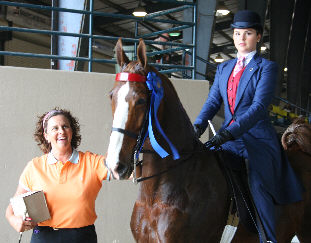
Renee Biggins with her daughter Ashley
Renee Biggins, Biggins Stables, Kentucky
World’s champion equitation and performance trainer Renee Biggins looks for elegance in her teams.
“I try to match the elegance of the horse with the elegance of the person,” she explained. “If the horse moves elegantly, I have to check its personality. Watching horses at shows or their barn is when I can start picking up on that, on whether they are easy or hard to work with.”
If a horse is out of state and she hasn’t had an opportunity to see it show, Biggins will look at videos. She says she doesn’t buy a horse without the prospective owner riding it.
“I try to hang out at shows when they’re working horses. I watch them in the warm-up and show ring,” she said.
Spirit Stuff was a horse Biggins had watched for several years. The gelding had been successful in the three-gaited division when she selected him for Claire Nilsson. Biggins equitated him after the Nilssons bought him from the Frickey family.
“I had seen him show and went to his barn. Claire and I both rode him and I watched him work again when they vetted him. They won the AHSA Medal and UPHA Challenge Cup National Finals in 1999.The following year, they brought home world’s championship honors in the 17-year-old age group and Kentucky State Fair Senior Equitation Championship.”
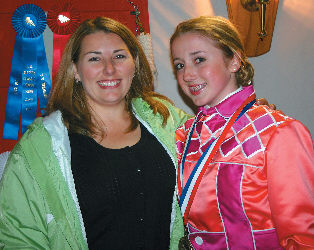
Heather Boodey with Caitlin Leith
Heather Boodey, Ingleside Farm, North Carolina
Boodey is one of the ‘young trainers’ who has made a name for herself in the Carolinas as well as on the national scene. Her forte is junior exhibitors; more than one leading trainer has said she is the first they call when they need a horse for a juvenile. She is equally successful with amateurs and equitation riders.
“The biggest thing is you have to know who you can trust. I always do a lot of research – where a horse came from, where it’s been. I make lots of phone calls and try to talk to everyone who has had it. I want to be sure I can make it work,” she said.
Boodey saws she tries “to be real careful about their money. I want to try to get them a good investment so they can get at least a little bit of money back out of it. My goal is for people to stay in the sport for the long run, not buy one big horse and be broke at the end of it. A $10,000 horse is good if you should get $7,500 back out of it.”
Boodey concedes that takes a lot of looking. “One thing helped me. When I was a kid, I didn’t have parents who could spend a lot of money and if the horse didn’t work, donate it. Not everyone has clients who can buy another one. I put in extra hours to make sure the combination works. If you work hard enough, almost any combination will do so.”
Two of her pairings raised eyes at the time. The first: buying CH My Korbel for Victoria Woodruff.
“He was older and hadn’t been a juvenile horse before. People weren’t sure he could do it. And she had never ridden a gaited horse.”
Caitlin Leith skipped academy altogether. Boodey and Leith’s parents bought CH Future Treasure and shipped directly to Bonnie Blue where she showed walk, trot and canter.
“I can see a kid on a horse and know whether I can make it work,” Boodey said. She has been right most of the time.
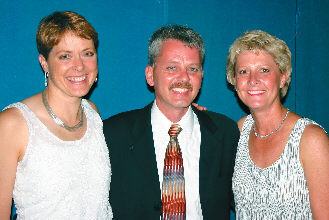
Wendy Troyer with Paul and Betsy Boone
Paul and Betsy Boone, Boone’s Farm, North Carolina
Paul and Betsy Boone are another most successful husband and wife team. Bill and Ann Cannon, along with their children, Will and Leslie, have been clients for more than 19 years. Boone selected such horses as CH Moonchance, CH Mountainview’s Starlike Reviews, It’s Me Again and CH Sultan’s Earth Angel for Ann, Leslie and Will. Two of his more recent selections, at least one of which raised eyebrows among knowledgeable fans, were Carlswald Prince’s Dominoe for Dr. Wendy Troyer and CH Yes It’s True for Kathy Lyda Berger.
Boone’s Farm has a thriving academy program. “About 90 percent of our riders come from academy,” Paul Boone said. “You have all levels of riders and have to adjust your thinking for that. When I was a kid, you could find something, fix it up, sell it and make some money. Horses now cost what they’re worth at the time you look at them.
“What we try to do is educate prospective buyers very heavily before they get into a show horse. A lot of it is not trying to sell a horse when a client is willing to pay for one but to wait until they are ready, when they understand it. A client needs to know what this sport costs, what to expect. They are going to have good and bad times. A horse can take you to every extreme you can have. One can make you love and hate it.”
Boone says he looks at a “certain amount of videos, but I haven’t found them worth the aggravation. There’s no way to capture a horse at home or at a show that does justice to the horse. I usually judge by a horse’s show record, whether it’s competitive or not. I talk to the trainer to learn about its mouth and situation. I’ve seen horses that look wonderful to tape, like what I need. Then I fly and look at them and they’re not. On other occasions, I haven’t had tapes and someone else buys them. Then I realize that horse was exactly what I needed.”
Boone says he may go look at a horse alone. “Depending on what I’m looking for, it often is a two-trip job. About half the time, the customer goes along. Often, you don’t need to go look at something as you happened to see it at a show. Normally, we decide to go look at it later.”
Troyer’s purchase of Carlswald Prince’s Dominoe is a case in point. She purchased the gelding after Melissa Moore won the Five-Gaited Stake at Asheville. After good rides at the Carolina Classic and Blue Ridge, they headed to Louisville where they tied third in the Ladies Five-Gaited Gelding Stake and reserve in the ladies championship, one of the most exciting classes of the show.
“Wendy won’t buy a horse unless it’s a challenge. Her work is very meticulous and she plays hard the same way,” Boone said. “She understands that in this business sometimes you’re the windshield and sometimes the bug. Wendy may be atypical in buying; she always wants a challenge. Her whole career is built around a challenge.”
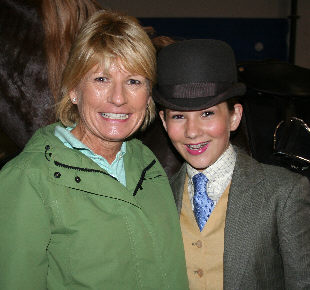
Sarah Byers with Mollie Kregor
Sarah and Rob Byers, Premier Stables, Kentucky
A client’s goals, division preference and financial ability are the first thing Sarah and Rob Byers consider when beginning what she calls “the buying procedure. We talk about their reality, what is realistic for these things. In some cases, we can make their goals and price range work if they let us select a horse based on the nicest thing we can find for any division. The basic thing is we have to select a horse suitable to their ability.”
The Byers look at videos only for themselves as clients often tend to pick them apart. They take the same tactic when sending out videos, asking trainers to look at them to ensure it’s worth the trip. She concedes that most of their clients don’t want to wait a long time to find a horse. The first of the criteria is whether their personalities are going to match.
“We try to make a differentiation when we look for a ladies or an amateur horse. We stick with what the criteria are supposed to be: a little prettier for a ladies horse, more aggressive if it’s an amateur horse,” she said. “We have so many of those riders, it’s important to keep them in specific divisions. Sometimes with kids things work out even though the horse isn’t something we bought for them to go together. Nathan [Stein] and Callaway’s Buttons And Bows’s personalities complement each other so much. People fell in love with her again because of that combination.”
Buying I’m Royalty Too for Rosemarie Fernandez demonstrates another facet of the personality question. “We put her on him outside one afternoon at Louisville. We knew it was going to work. We thought, ‘If she can ride that junior horse out here and look that comfortable…’ we knew his personality would suit her.”
There’s still another aspect of putting the new picture together. Sarah Byers explained, “After someone does buy a horse, they have to select a riding suit for that specific horse. My main goal is to be sure everyone’s suit complements their horse. Another thing we really expect is that they will be as dedicated to their practice riding and working out – whatever it takes for them. They need to be there to ride to their horse’s ability. Most of our people ride at least four to five days a week on lesson horses when they are in town.”
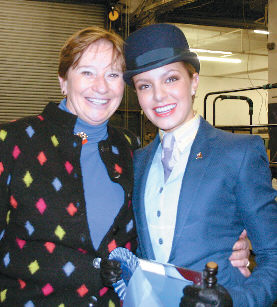
Lynda Freseth with Rachael Machamer
Lynda Freseth, Hollow Haven, Wisconsin
“It’s hard as heck to find them,” Lynda Freseth said when asked about buying new horses. She does most of the shopping herself.
Freseth spoke frankly about the steps she goes through before even starting on her quest. “First we sit down to talk about the entire situation. Age dictates what some people can ride. With greener adults, we aim at the country pleasure division because in pleasure manners are paramount. We need to look at what the horse can teach that green rider.
“I’ve found over the years that people who skip steps are behind the eight-ball all the time. They’re not happy because they’re not doing well,” she continued. “We decide how much talent and experience a rider has and talk about the price tag. That gives us an idea of what circuit they need to stay on, what division they need to be in.”
Freseth “isn’t happy that I can’t find a competitive ladies gaited horse for a moderate amount of money. This day and age, I can’t find anything for a moderate amount of money. I was in Kentucky for an entire week, visited every barn I could possibly think of and came home with one horse. I saw a lot of horses, but when you begin thinking about a horse’s personality and the division the rider needs to be in … it’s very, very hard to find suitability. And then you work the dollar. Finding something that’s worth the money you’re spending is very, very hard to do.”
Freseth says knowing your rider is of primary importance. Can they ride a game horse? Are they better at saying whoa or better pushing one. The rider’s proportions also are very important. A tall person who is ‘all legs’ may not need a long-necked horse; a short person who is long-waisted needs a lot of neck.
Total picture is the first thing Freseth considers. “It is a horse show. When you send a team through the gate, it should be pleasing to the eye. Judges make snap decisions on a ‘bleep of a look.’ There has to be something that guides a rider away from the rest. I work very hard to do something that accomplishes that.
Freseth concedes that she is hard to please. “I know I’m becoming a fuddy-duddy about the horses I buy. It’s true that the older I am, the more critical I get. I used to find horses I really liked and would see if I could find someone to buy it. Now we have more buyers than horses. Competing on the level we are today is quite different than when I was in Virginia or Illinois.
Hollow Haven runs an atypical academy program. Freseth teaches the riders herself.
“We have six little kids that are teensy – two five-year-olds, one who is six, one seven, one eight and one 10-year old,” she said, explaining she teaches one or two youngsters every afternoon. Our riders can stay in academy two years and buy a horse – or that’s it. I feel academy should be a stepping stone, rather than an end result.
“I think the Alpha division is wonderful, especially for adults who have not ridden and shown in a long time. It’s a good break-in point from Academy. Anything we can do to have stages and not slap someone with a humongous amount of money to buy a horse is good for the business,” she added.
The Freseths do use videos, but rarely with clients. “One thing I emphasize to people sending videos is that it is for me to look at. You have to have a trained eye. I do video when I go to look. However, when I bring it back, I don’t go through the whole thing with a customer. When I have found a horse I’m interested in, I show my video of that horse and tell the customer, ‘Right here is a real good representation of what the horse looks like; here it isn’t.’ You can get a little bit of a silhouette and see the way a horse uses its legs, but there’s no personality and no expression through a video at all.
“You can see how well broke one is and how it does patterns,” she added. “I think a video is a good jumping off place.”
Freseth does a lot of traveling and spends hours on the telephone. “Networking is a huge thing. One thing I realize is that when someone can describe a horse to you, you put together a mental picture of what they’re saying. If you get there and it doesn’t look like your mental picture, it doesn’t mean someone has misrepresented the horse. That’s the way they look at it. I learned a long time ago that one person’s long neck is not another person’s long neck. If you listen to what everyone says, you will miss horses.”
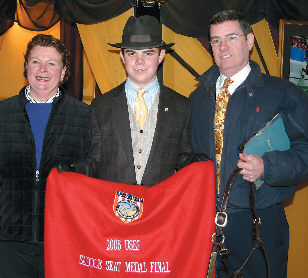
Marsha and Gary Garone with Kyle Gagnon
Gary and Marsha Garone, Fairfield South, New Hampshire
The chosen division, client goals, money, experience level and the rider’s general psyche or personality: those are the first things the Garones address. Like their peers, they face the challenge of finding horses to fit those needs.
“These days, it’s hard to find 15 horses to look at,” Gary Garone said. “We tell a buyer, ‘This is what we probably can accomplish with your money.’ It’s very hard to find horses that truly represent that price range or level of what you’re gong after.”
Garone says that, using this approach, he considers he has failed only once. Persistence has led to their buying almost everything they wanted.
When Garone speaks of psyche, he means the riders’ personalities. Are they game or quiet and passive? Are they hungry, aggressive?
“You have to know your rider,” he said. “Some people are so driven that we can get them to buy something that needs to be pushed. With a more passive person, we have to be more careful. We can’t push or over-mount them. That can be very tough.”
Still, it works. The pairing of Jessica MacLeod and New York Entertainer is one success story. “It possibly was a step or two up the ring on the lady from where she was. But through hard work, determination, persistence and patience, they were successful last year,” Garone said.
The team won a world’s championship in one section of the Junior Exhibitor Show Pleasure 14-17 competition last year.
“Her personality, intelligence, support and non-pressure from her family allowed her to continue to learn and advance herself,” he added. “She’s getting to the point where she is able to learn and make changes so she can have the very best ride she can – for herself.”
The Garones talk of personal best, whether in the performance or equitation divisions. “We were watching a coach during March Madness [NCAA Basketball playoffs] who was talking to his team in the locker room three years ago. He spoke about execution, not expectation. If you are executing correctly, your expectations generally can be met if you set realistic goals and don’t have your head in the clouds.”
Garone’s mother is a successful high school basketball coach. “Marsha and I used to talk to her about emotion, pressure and drive for the team. Some people in riding don’t have that drive. Trying to do the best we can for the money a client is spending with one part of the team not being totally focused is hard to achieve.”
Like most trainers, the Garones face the competition with everything from other sports to fitness, video games, school activities and a rider’s social life. “There’s so much for these families to do these days; they have so many choices,” he said. “They can do horseback riding or a team sport at school. It’s unusual to have someone whose attitude towards riding is a strong as we might want.
“We have to consider whether or not the youngster only rides. Will they be in a position to practice as much as they should? When parents are 100 percent behind a child’s riding, it allows trainers/instructors to do their job. Being given the opportunity to take the time and develop a horseback riding team is fun. It doesn’t happen overnight. Riders have to work through rough patches, to grow into showing a nice horse and to be competitive at shows,” he said.
“A rider is set on a journey of learning, growing, changing and developing through different horses. Ours is an individualized sport where people from all different walks of life are trying to do same thing. Some have a natural work ethic. A small percentage of riders can and do excel in this because of their makeup. It’s how they approach everything. A lot of people can play the game. Only a few are naturally talented; that few have all the ingredients come together. Still it takes little bit of luck to have the winner that day. What keeps us going is the idea of that perfect ride.”
Garone pointed to world’s champion equitation rider Kyle Gagnon as one who “has the work ethic of a workaholic. He’s very driven and doesn’t approach any ride without feeling there’s something to be gained from it. He approaches every ride as if to have the ultimate ride.
“Some kids aren’t quite that driven, don’t have that sense of importance. Sometimes they have to learn through going to a couple of shows and watching people show what real hard work is.”
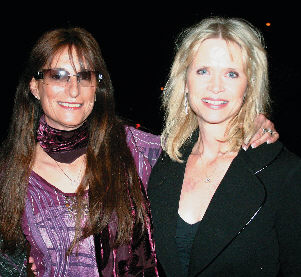
Ruth Gimpel with Patricia Bonati
Ruth Gimpel, Ruth Gimpel Stables, Florida
Ruth Gimpel’s success in putting winning horse and rider combinations together goes back more than 30 years. Her first successful pairing was 11-year-old Kim Boros with the equitation horse Crown Royal. It wasn’t long before Bill Rodgers’s family purchased his first horse, the road horse Gentry Mac.
She’s been developing successful combinations ever since.
“I try to find the best horse that I think I can teach the child or amateur to ride. I still want to see it. The best way is in the show ring, a lot of them look better in the barn. I like to look at their conformation and their feet,” she said, pointing out that being in Florida can bring a number of foot problems.
“A lot of times I don’t take the amateur or juvenile with me. Having them ride the horse is not as important as having me ride them. Hopefully, I won’t buy something they can [really] ride that day. I want a challenge.
“I almost lost my best friends over buying CH Tigerlee,” Ruth Gimpel said of one of the more daring combinations she has put together. “People wondered how I could do that to a nice lady like Helen (Rosburg) and a kid like Ali. I thought I could put it together.”
History certainly has proven her right. “I always have questions … will I be able to fix that horse for that child?” she said.
“You have to get kids to where they trust you. You have to get in their heads and not just be a teacher. Be their friend, teacher, someone they look up to and they will ride their guts out for you,” she continued.
She spoke of Ali and CH Tigerlee. “Tiger is really a game, game horse.
“Training [and selecting] a horse for the trainer to ride is one thing. Training for amateurs and kids is a different deal. It’s what I love to do.”
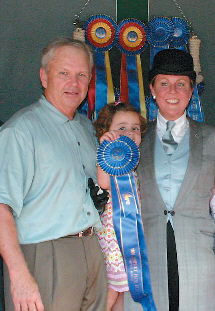
Nelson Green with Ceil and Sallie-Mason Wheeler
Nelson Green, Nelson Green Stables, Kentucky
Nelson Green’s program is different than many other successful trainers. He has no academy program, keeps no ‘lesson’ horses. The many-times world’s champion trainer runs a comparatively small operation, with just a 21-stall barn. He has less than a handful of amateur, ladies and junior exhibitor riders. All are quite experienced and committed to being in shape to ride.
“Putting a horse and rider together isn’t a science to me,” he said. “I look at the size and temperament of the rider and horse and the rider’s ability compared to the horse’s requirement. Once we get past that, I try to find the nicest horse that they can afford.”
“Some of my clients take lessons other places,” he said in his understated way. Sarah Sessoms rides at home with Johnny Lucas. Ceil and Kenny Wheeler ride on their Virginia farm. As for other riders, “Bill and Nancy Becker’s barn is within eyesight of mine. Clients can go there to ride a school horse.”
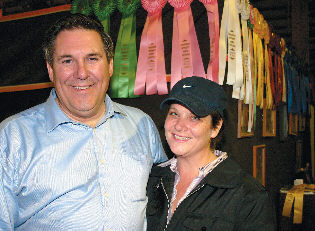
Scott and Carol Matton
Scott and Carol Matton, Knollwood Farm, Wisconsin
Scott and Carol Matton’s approach to horse ownership is almost diametrically opposed to most of their peers. Knollwood Farm has one of the largest – and most successful – academy programs in the country. Virtually every one of their show riders has come through the Knollwood Farm School of Riding.
“Nancy [Turner] and Ann [Wilt] do a great job with it,” Scott Matton said. “They make 17 academy and ‘B’ shows throughout the year.”
Such preparation has riders ready to step up to the ‘big barn’ and show horses. Here again, the Mattons take a different approach.
“What we’ve done is eliminate that ‘first’ horse,” Matton said. “We back riders off a year or two by keeping them in academy until they are ‘finished’ learning from a school horse.
“Parents will tell us, ‘We’re ready to go.’ We say, ‘No, you’re not. You haven’t finished with school horses yet.’ Until we feel your kid’s ready to go, we’re just going to be mad with each other. Just because someone has the money to buy a horse doesn’t mean they’re ready for it.
“We have so many different horses for students to learn things on. We don’t have to get rid of that cheap, lazy horse. Their own first horse actually is a second one,” he explained.
Young Nick Maupin’s career illustrates Matton’s point. “We used our academy horses to progress him through the program. The first horse his family bought, Oh What A Feeling, is a nice show horse.”
When he ‘graduated,’ Maupin was ready for the big time. He won the Pleasure Equitation 13 and Under class and a reserve in the UPHA Challenge Cup at his debut show. He ended the year as the UPHA Junior Challenge Cup National Finals Reserve Champion, American Royal Saddle Seat Equitation Reserve Champion and Saddle Seat Equitation 13 and Under Champion. That’s what they call ‘The Knollwood Way.’
Many of the Matton clients are equitation riders. “One of the first things we have to determine is how physical the rider is. A horse has to be game enough to be able to tell it whoa. It can’t be silly, but a rider can’t push and beat it down the rail. It’s hard to equitate and push at the same time. Sarah [Thordsen] and Michelle [Krentz] went from CH Jazz March to CH Louisville Lass. Lass was game enough to handle what she was doing. You could say whoa and ride smooth.
“Everyone wants the same thing. They hope to find a three or four-year-old and equitate them,” Matton added. “A finished equitation horse is worth its weight in gold.”
Actually, Matton says you find the same challenges in any division. “Most older people can’t kick one and let one up, can’t set a horse’s head and push at the same time. That’s why good horses are so expensive.”
Matton says one of his challenges is that Lynda Freseth is just around the proverbial corner. They compete as hard in finding horses as their riders do in the show ring.
“I bought my last gaited horse yesterday,” he said at the time of this interview. “I also looked at 35 horses for one kid and couldn’t find it.”
He does look at videos, but most of his shopping entails travel. “I get in the car and drive. I get a plane ticket, get in the car and drive. You have to be patient. The horse you want isn’t always the most expensive.”
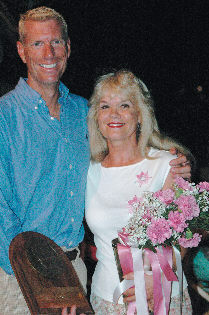
David Rand with Sandy Hendrick
David Rand, Rand Stables at Sheafer Farm, Maine
Being tightly networked within the Morgan industry enables world champion trainer David Rand to “know what everyone has. We review what my client wants and start looking.
“The first of my criteria is quality. I look for the highest quality the client can afford. Next is suitability, the horse’s mental ability. It doesn’t necessarily need to be all ready for my rider, but the way they think, their personality and how they do their job is important.”
Knowing his riders and their goals is paramount to Rand. “I need to know what level of success they want to have. I don’t go shopping until I know what I want and the client has the money,” he said frankly, explaining he does a lot of homework before setting out to look at a horse. “I’m not afraid to buy something that isn’t completely perfect. I like the challenge of putting a finish on the horse and putting the combination together.
“Working horses and getting people to work with their horses takes up most of our time,” he said, explaining they work 45 head and have no lesson program. “Most of my customers can ride pretty well when they come to me. They have a goal in mind when they come. Most love show horses and want me to work with them.”
Rand believes in training the horse to the rider, not the other way around. “A horse has to be very trainable so he can deal with what’s going to arise from his rider. That’s where our success comes from. People are what they are, they’ve got the ability they have. We try to get a horse rock solid and school him so he can deal with a rider that may become very nervous in the show ring. What they do at home is about half of what they can do at a show. We push them to ride really strong, to go wide open at home. Everything changes every time you go through the in-gate. A horse has to really know when things are different and what they have to do.”
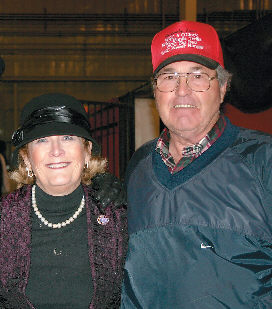
Judy McNeish with Raymond Shively
Raymond Shively, DeLovely Farm, Indiana
“I hate videos,” the always-direct senior trainer at DeLovely Farm said. “I do look at them. To me they don’t capture the character of a horse, its heart or anything. It’s all right but I don’t know. I go see the horse and may not be same horse you looked at on video. I am going to look at him; I’m going to try him out.”
Shively concedes that sometimes one doesn’t have quite the rider he might want. “It makes a difference. Some can push a horse and ride a horse that’s a little laid back. Others can’t ride that kind; they have to have ‘go forward.’
“The overall thing you start with is the total picture they present,” he said. “Sometimes you’ll find a horse you like that doesn’t fit your rider. The horse may be too small or the rider too small. Take Deborah [Butler] for instance. You have to have a big horse for her. People like Hunter [Chancellor] are small and you go with a smaller horse. Finding the right horse for that right rider gets difficult at times. We’ve been real lucky to find some things.”
He spoke of the challenges presented by clients’ preferences. “Some customers don’t like a horse with a lot of white; others want a lot of it. It gets a little … not easy. I can’t tell you how many miles I’ve driven this year to look at horses. The ones you want to buy are not for sale. We get calls here every day about horses here in the barn. These people don’t want to sell.”
Pedigree plays little role in the horses Shively selects. “I’ve had real success with horses that didn’t have any pedigree to them at all. They had no right to be a nice horse, but they were. Summerfield’s Dream Girl was by Sixpence Harmony. I found out he later was gelded and a five-gaited pleasure horse. China Silk’s Revelation was by China Silk’s Mr. C. I never heard of another one by that horse.
“I don’t care if they’re by The Side Of The Road and Out Of Gas,” he said in his inimitable way. “You never know where they’re going to come from. If I like a horse, I like it.”
|